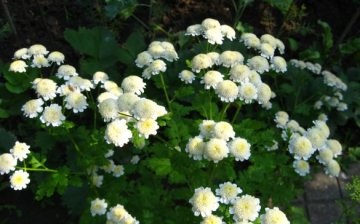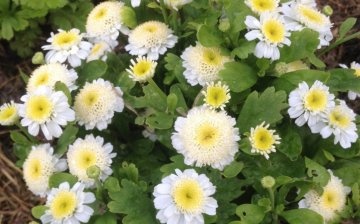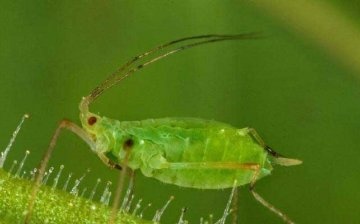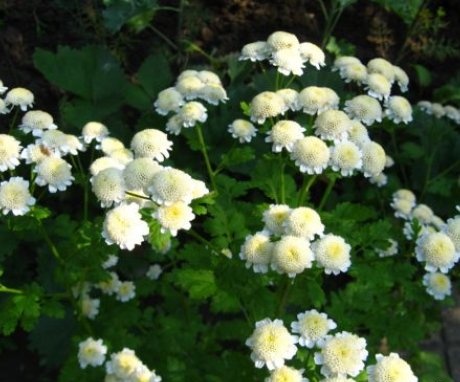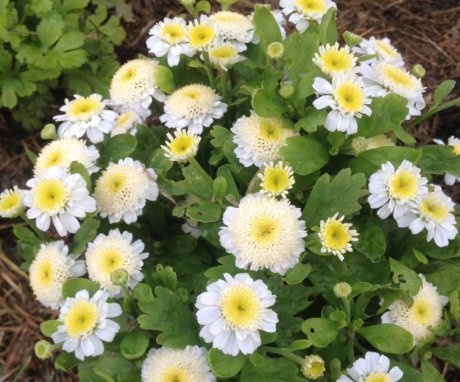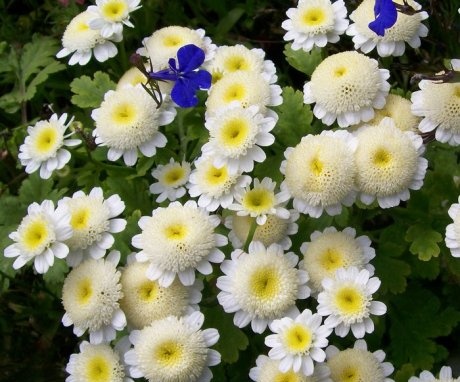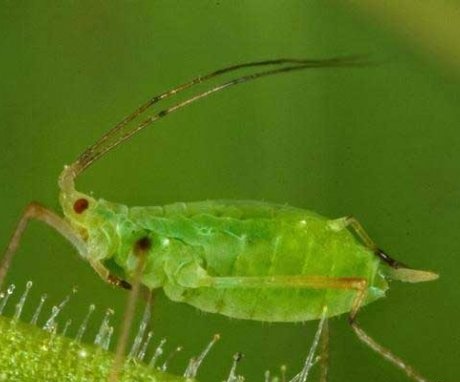Feverfew maiden - a beautiful and unpretentious plant for the garden
The flower called Pyrethrum will appeal to everyone who loves the simplicity of chamomile. This flower resembles a chamomile, but has a variety of bright, unusual colors. Feverfew maiden has white buds, depending on the variety, it resembles either chamomile or chrysanthemum. Feverfew will decorate any garden plot without requiring complex maintenance.
Content:
- Description and varieties of Pyrethrum maiden
- Planting and breeding
- Growing conditions and care
- Diseases and pests: control and prevention
Description of feverfew maiden
Feverfew belongs to the Astrov family. Feverfew maiden more than all the varieties of this plant resembles chrysanthemumtherefore it is sometimes called the maiden chrysanthemum. The name feverfew means fever. In ancient times, this plant played a more medicinal role than a decorative one, it was relieved of heat and fever.
Among the people, Pyrethrum is sometimes called Chamomile or Chamomile.
Features of the plant:
- Feverfew is a perennial plant, but more often gardeners grow it as an annual. Perennial pyrethrum does not live long (no more than three years) and at the same time its decorative qualities weaken every year.
- The plant takes root easily and is very unpretentious to care for, so it is easier to plant it on the site every year than to fight for its flowering for 2 or 3 years in a row.
- Some varieties of Pyrethrum maiden can grow up to half a meter in height, but there are also dwarf varieties no more than 10 cm high.The average flower size in height is 30-40 cm.
- Feverfew maiden has beautiful white buds. At the edges they have petals like chamomile, and in the center there is a large rosette resembling a chrysanthemum.
- The bush itself is quite dense, branched, dense greenery, collected in the lower part. Leaves are bright green, feathery.
The varieties of Pyrethrum Maiden are varied. Among them there are double flowers, pompom flowers, yellow and white. Most often, maiden feverfew has buds of a delicate white color. Especially popular are varieties called Double White, Goldball with double bright yellow flowers, Virgo with beautiful white buds in the form of large balls.
In the wild, Pyrethrum can be found in the regions of the Ciscaucasia and Transcaucasia. Here in the summer you can see a huge amount of pyrethrum of all possible colors. It was from the Caucasus that the study of this plant began more than two centuries ago.
Planting and breeding
Feverfew is usually propagated by seeds and less often - cuttings... The seed method is simpler and has a greater survival rate. Reproduction, planting and care does not require any special effort. Some gardeners recommend planting feverfew and forget it will grow on its own. However, for this you need to choose the right place, plant the plant on time and take care of the soil. If the conditions of your region or the soil on the site do not allow not to take care of the plant at all, it is better not to neglect the rules of care.
Methods of reproduction of Feverfew:
- If you want to propagate feverfew this summer to get more bushes, take the young root shoots of the plant. Dig them out carefully so as not to damage the roots. This will not do any harm to the mother plant.Plant the dug shoots in pots or directly into the ground, but carefully cover with foil.
- To propagate Feverfew with seeds, you must first collect them. Collect the seeds in the fall, when the flowers have faded. The seeds are dried and stored in a dark dry room until spring.
- Feverfew is propagated by seedlings. In March, ready-made seeds are sown in a container with prepared nutritious moist soil. Seeds it is necessary to distribute on the surface of the soil and carefully sprinkle with a thin layer of earth. You do not need to try to sprinkle the seeds thickly, they will interfere with each other when pecking. After planting, the container with seeds is taken out to a bright but cool place. The temperature should be no more than 20 degrees. After that, the seeds will begin to hatch. If you see that you have planted seeds too often, after the leaves appear, they can be thinned out. As soon as the seedlings grow up, they are seated in separate cups. When the seedlings adapt and get stronger, they can be planted in open ground. It is best to do this in May when it gets warm enough.
The place for the landing of Pyrethrum must be chosen especially carefully. They can be grown in partial shade, but it is better to choose a well-lit place. In this case, for the first 2 weeks, it is better to cover the plants from the midday sun so that young shoots do not get burned.
Grown from seeds, Pyrethrum does not retain the qualities of the mother plant. When planting, flowers of any color may appear. Plants grown from seeds begin to bloom 2-3 months after planting.
Growing conditions and care
Caring for Feverfew is very simple. In order for a flower to grow and bloom well, it is enough to follow a minimum of care rules:
- Despite the fact that Feverfew is girlish unpretentious and needs almost no care, you need to regularly remove weeds from the flower bed. This is necessary not only to maintain a beautiful and well-groomed appearance, but also to better grow flowers. Weeds deplete the soil, take away nutrients, it is especially important to weed the flower bed during the period of active growth of Pyrethrum. When the flower grows, it deals with the weeds on its own, suppressing their growth.
- Feverfew does not need frequent watering, but if the summer is hot and dry, you need to water the plant as needed. Make sure that the soil does not dry out or crack. The plant tolerates drought well, but with a prolonged lack of moisture, the flowers begin to shrink, the colored buds become lighter. Do not overuse the persistence of Feverfew.
- Like any garden flower, Feverfew needs to be fed periodically. Four times per season must be applied to the soil mineral fertilizers... You can buy a ready-made complex mineral fertilizer in granules at a gardening store. It is convenient to plant it and add flower beds to the soil.
- If you want to grow Pyrethrum as a perennial plant, take care of preparing for winter... In the fall, when the plant has bloomed and the seeds are harvested, you need to cut off dry stems and faded buds. For Feverfew to survive the winter better, the earth around the roots mulch foliage or hay. If winters in your area are harsh, cover the entire plant with fir branches. This coating will protect the flower from freezing.
- Feverfew blooms for a very long time. After winter, the perennial Feverfew begins to open its first buds in May-June. After that, the buds dry up and spoil the look of the flower bed. If you carefully cut the flower, remove the buds, this activates the growth of new ones, renews the plant and gives the flowerbed a well-groomed look.
- When it rains, it is recommended to slightly loosen the soil near the roots. This will allow oxygen to penetrate to the roots, and a crust will not form on the surface of the soil, which traps moisture.
Diseases and pests: control and prevention
Feverfew maiden has good protective properties and is resistant to adverse environmental conditions, but nevertheless, sometimes the flower is affected by pests and diseases:
- Aphid... These are small green bugs that are located on the back of the leaves or on the shoots themselves. Insects secrete sweet dew, which creates favorable conditions for the development of fungal diseases. At the very beginning of the onset of the disease, the affected leaves can be removed and the plant thoroughly washed, washing off the insects with water. If one of the plants is severely affected, it must be removed from the flower bed and burned. You can spray the plant with an insecticide.
- Slugs. Slugs often like to feast on the leaves of Feverfew maiden. They are easy to spot, they are rather large pests, but they can hide. Slugs leave noticeable damage to the leaves of the plant. If there are many slugs, they can destroy the plant in half a day. If you look closely under the bushes and look under the stones, you can quickly find them. Birds and hedgehogs fight slugs, so you can feed them for pest control.
- Gray rot. The causative agent of this disease is a fungus. The infection affects fruits, buds and leaves of plants. They turn gray, wrinkle, fall off. Curing gray rot is not easy. Often you have to destroy the plant, burn it, cultivate the land fungicide and plant the plants again the next year.
- Thrips. Thrips are insects that are often found on garden flowers. Thrips are very small, about 2 mm, they can be detected by the damage caused. Larvae are light yellow, adults have wings. You can get rid of thrips only by removing the affected plant parts.
- Fusarium. An infectious disease also caused by fungi. First, the roots begin to rot, and then traces of rot appear on the stems and leaves. This is a very common disease of garden plants, therefore, for prevention, it is recommended decontaminate all seeds and soil. Often the death of a plant with fusarium is inevitable, so the plant is removed, burned, and the soil is cultivated.
With proper care and preparation of the soil for sowing, many diseases can be avoided. The soil must be treated in advance from spores and larvae, as well as monitor moisture.
More information can be found in the video:




